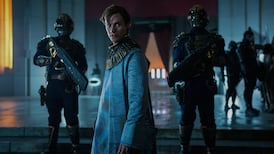The most chilling scene in Unquiet Graves (RTÉ One, Wednesday) comes at the end as the screen turns dark and the names of the victims of the 1970s loyalist Glennane Gang are listed line by line, death by death.
On and on it goes and even if you try to do what feels like the right thing by reading each entry, the task soon becomes impossible. There are simply too many gunned down, blown up, murdered in their cars, at home, taking a pint at the bar.
This feature-length documentary by Belfast film-maker Seán Murray is grim going. And to an Irish audience it in truth contains little that feels shockingly revelatory.
Narration by <a class="search" href='javascript:window.parent.actionEventData({$contentId:"7.1213540", $action:"view", $target:"work"})' polopoly:contentid="7.1213540" polopoly:searchtag="tag_person">Stephen Rea</a> is understated. He knows it's his job to get out of the way and let the victims speak for themselves
As we are all at least vaguely aware, loyalist death squads frequently working in collusion RUC officers and Ulster Defence Regiment soldiers killed Catholics with impunity in Armagh and Tyrone. There are no surprises. Just a reminder of how evil took root and spread.
This all happened through the darkest years of the Troubles as the bodies of innocents piled up on both sides.The gang’s victims also include the 33 killed in the 1974 Dublin and Monaghan bombings.
Shamefully, the true extent of the conspiracy behind those atrocities has yet to come fully to light.
The big revelation in the documentary, which had its premiere in Belfast in 2018, is of a plan to have the UVF shoot up a nationalist school at Belleeks in Co Armagh. This would have essentially triggered full-blown civil war in the North – and, so went twisted British logic, force the IRA into the open. Untramelled fantasy.
Murray, a nephew of Danny McCann, one of three IRA members killed by the SAS in Gibraltar in 1988, spruces up the narrative with dramatic flourishes. He reenacts a roadside killing by the Glennane Gang. Later, a reading of Séamus Heaney's Strand at Lough Beg, written for his second cousin Colum McCarthy, after he was killed by loyalist paramilitaries, is accompanied with a moving animated sequence.
The attitude would have been, 'you're doing a great job but don't get caught'
Narration by Stephen Rea is understated. He knows it's his job to get out of the way and let the victims speak for themselves.
There are many heroes. Campaigning journalist Anne Cadwallader, author of Lethal Allies and among the first to report on a "triangle of death" in Armagh and Tyrone. And Margaret Campbell, who recalls being forced to point out – and then touch – her husband's killer at an RUC line-up (no arrests were ever made).
Most disquieting of all is the interview with former RUC officer and UVF volunteer John Weir, convicted of the 1977 murder of Catholic man William Strathearn. He describes the plans to attack the school in Belleeks (too much even for loyalist paramilitaries who had cultivated a taste for blood).
“It went to the very, very top,” says Weir of British collaboration. “It crossed the water where the politicians knew what was going on and gave the go-ahead. The attitude would have been, ‘you’re doing a great job but don’t get caught’.”












